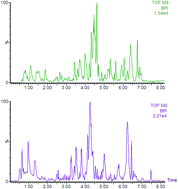Urine metabolic phenotypes analysis of extrahepatic cholangiocarcinoma disease using ultra-high performance liquid chromatography-mass spectrometry†
Abstract
Extrahepatic cholangiocarcinoma (ECC) is the second most common type of malignant primary tumor with a poor survival rate and an increasing global trend. However, the metabolic phenotype characteristics of ECC have not been explored. Metabolomics has shown significant potential in identifying small molecules specific to disease phenotypes. In this study, liquid chromatography-mass spectrometry (LC/MS) in combination with multivariate statistical analysis was conducted to explore the urine metabolic changes of ECC. An untargeted metabolomics assay was conducted on urine samples of ECC patients and healthy controls. Multivariate pattern recognition analysis was used to reduce the high dimensionality of the metabolome dataset, differentiating between the ECC patients and healthy subjects. Score plots of the spectra revealed the separation between the ECC cases and controls for the level of metabolites. A total of 19 differential metabolites were identified and contributed to ECC. In the pathway analysis, a total of 29 significant metabolic pathways were identified. All the metabolic perturbations in the ECC disease status are associated with three key pathways, including pyruvate metabolism and citrate cycle, and these metabolic pathways may provide a potentially new target for diagnosis and therapy. Of note, network analysis found that abnormally expressed metabolites were tightly correlated with the metabolism pathway. The identified differential metabolites and metabolic pathways responsible for ECC were all imported into a web tool for network-based interpretation of compound lists to interpret their functional context, molecular mechanisms and disturbed pathways. Overall, it demonstrated that clinical metabolomics may highlight biomarkers and pathways and can capture subtle metabolic phenotype changes from ECC, which may lead to an improved mechanistic understanding of ECC.


 Please wait while we load your content...
Please wait while we load your content...